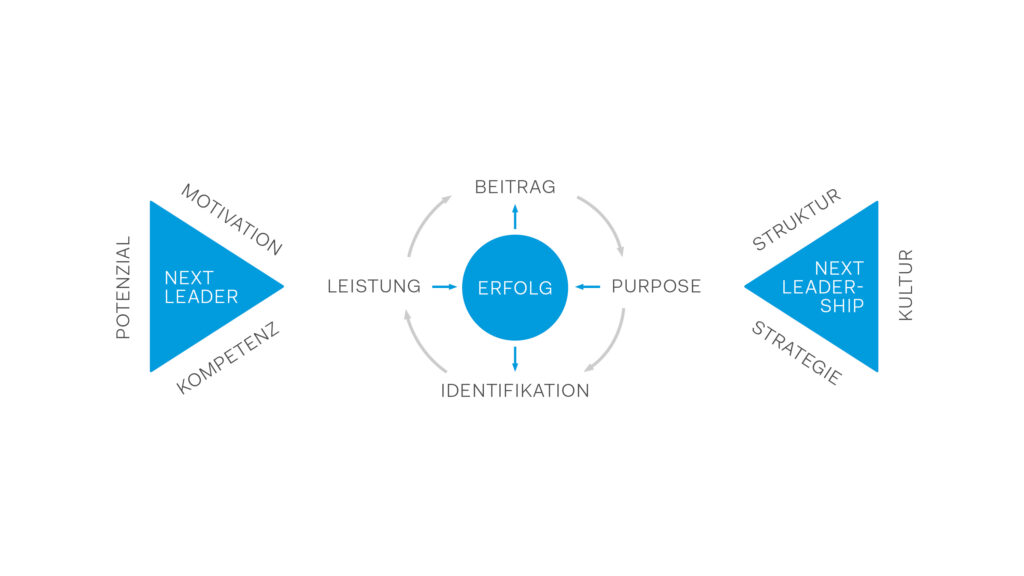Success arises from the right interaction between person and organization

Leadership theme. What makes for successful leadership? And when exactly is leadership successful? Because leadership should not only be good, but as effective as possible and generate success.
What does success actually mean? Success is not easy to define and must always be viewed in context. The word “follow” is in it, and means success follows something. In the economic context, good performance is hopefully followed by good results, and good results in turn are followed by success. However, success is ultimately something that others evaluate – the customer, the employee or society. And it is far from being an automatism according to the motto “If we make an effort and achieve something, we will bring good results”. Even if the results are good, it does not automatically mean that we are successful with them. The results must also be recognized and provide a benefit. So success is multi-faceted.
Success in the field of leadership always takes place in an area of tension between people and systems. Leadership is about people, success is about a social system making something happen, which is considered successful. The manager is always part of a system, usually part of an organization. Otherwise, there is no need for guidance. Even leadership in a family happens within a social space and in the economic context, leadership means being part of a system.
When we talk about successful leadership, we have to look at both sides: People and systems.
If one sees only the system, it means that leadership is successful when it serves the organization and the system. However, since leadership also relates to people, they cannot be disregarded. The ideal state would be that the person also perceives this success and that there is a match between the person and the organization. When leadership brings together the interests of the organization and the people in it, as well as generating a benefit for both sides, we speak of successful leadership.
For this reason, Strametz has developed a model that is very generic, but covers precisely this area of tension between people and organization and shows what it takes to be successful. Success is usually not an end in itself, but at the end of the day it brings about a contribution to a greater whole. Success also becomes more valuable when it is recognized by other people, organizations or the community at large. Success is rarely self-defined, but attributed. In this respect, part of the success may be a measurable contribution to the growth of the company, a contribution to an innovation and/or an increase in the quality of life. Contributing to society is already an important factor for many people today and it will probably become even more significant tomorrow. “What would the world be missing if our organization were no longer to exist? People find fulfillment when they feel that their work has a share in the success of the company. Moreover, they generate a contribution to the common good that goes much further. The importance of this contribution to the common good has been demonstrated in studies by Prof. Meinhardt (HHL Leipzig) et al. impressively outlined in the March 2018 issue of Harvard Business Manager magazine.
So people will not only ask: What is my contribution to the company, but what is the company’s contribution to society and to the world?
However, this contribution must have a reference value. This is mostly found in the purpose of the company.
That is, every company needs a purpose, a meaning, a mission. If this is fulfilled, the company is successful and in turn makes a contribution, which in turn has a reinforcing effect on the Purpose.
Secondly, meaning creates an identity and thus means that the company acquires a meaningful identity. And even more than that: the more the company fulfills its purpose and makes its contribution to society, the more the individual in the organization as well as the manager himself identify with the company. This identity is directly influenced by success and leads to higher motivation and performance.
Thus, the people of this organization are also motivated to continue contributing because they see a purpose, because it is identity-forming and contributes something to the big picture. A flywheel is set in motion, which rotates around the success, but also makes it visible and concrete.
What does it take for companies to determine the right purpose, the right mission, the right Purpose? Essentially, it requires three factors:
- Culture as the basis for interaction is (pre-)given, even if it can also be changed. It consists of the norms, values, and patterns of action of the majority of organizational members. Here, according to Edgar Schein, culture in the context of leadership is understood as a pattern of shared premises that the organization has learned in meeting its challenges of external adaptation and internal integration and is thus normatively binding.
- A strategy that describes the way in which the company’s purpose can be achieved and goals or visions fulfilled.
- A sensible structure that also serves the purpose. Structure is also the umbrella term for processes, functions and roles.
On the employee side, there are three factors to consider:
- The potential that people bring as a space of possibility.
- The ability or the competence. That which can be productively realized from the potential. According to John Erpenbeck, competence means the ability to act self-organized and creatively in dynamic, complex and open situations.
- Motivation. That which is ultimately the trigger for a movement and makes employees do something through effort and thus brings about performance. In the background, personal motives and subjective expectations influence what is wanted. Subjective expectancy is, on the one hand, the unconsciously estimated probability between effort and outcome and, on the other hand, the presumed probability between outcome and reward. This reward can be either extrinsically or intrinsically dominated.
In the context of leadership, both must always be considered: the person – both the manager and the managed employee who is ultimately expected to perform – and the organization. In the entire area of the management system, the management culture and also the management strategy, a meaningful management structure is required.
This means that what applies to companies and people on a large scale also applies to leadership. Simply because leadership has a big impact on whether and how things get done. Because managers are the intermediaries between the organization and its people, leadership plays such an important role in the harmonious interaction of the two, not least with regard to the joint successful creation of value.
For further interesting insights please have a look at our news section










